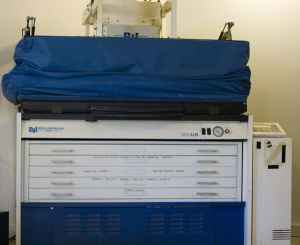Photopolymer Plate Maker
Does anybody know anything about this machine (picture attached)? I think it is called the Vaculux II Integrated Imaging System with MS-50 Integrator made by Burgess Industries and can be used to make photopolymer plates. Does anyone have experience making photopolymer plates and what supplies are needed? Thanks for the info!

Plate Maker
Most platemakers are fairly simple. The washout unit uses tap water, so you just need to have it hooked up and drained.
Not sure of the light source, but if it has an integrator it will compensate for bulb wear.
Platemaking vacuum units are sealed with kreene, not glass, normally. This will need to be replaced periodically as well.
If you get it hooked up all you will need is unexposed photopolymer, quality negatives and some time to calibrate it.
afliegs, that is a plate exposure unit. It just exposes the plate. It will need a bulb that has the correct spectrum
for photopolymer. You can sandwhitch the kreen between
the glass,and negative. if you don’t use kreen the plate
will have no shoulder. best james
This is the info I was referring to re: kreen and shoulder - I would say experiment and see what results you get - best of luck!
You can sandwhitch the kreen between
the glass,and negative. if you don’t use kreen the plate
will have no shoulder. best james
* james bourland
* on 8 Nov 10 (10:32)
I would not waste your time with this mammoth machine. First off it is not for photopolymer it is made for offset plates. The pressroom at the paper I used to work at had one of these. You are better off hunting for something small with a washout unit if you are serious about making your own plates. If not just use the pros available, platemaking prices are great these days.
Here’s what I never understood. Photopolymer plate makers use uv bulbs that look like black lights for exposure. That Burgess unit also uses a UV light for exposure but it’s white. Exposure times on the black light units are several minutes, but exposure on the burgess (for forest) was less than 30 seconds.
Is the light in the burgess altogether wrong for photopolymer or s UV light UV light?
I used to expose offset plates on a smaller platemaker than this. As far as I know they are completely different light sources. An aluminum plate for offset can be burned in 30 seconds using this unit but I’m not sure how it would work for pp. The light on these baby’s are so bright you need those folded down curtains (shown in pic) to be closed during exposure. The only thing it would be good for is the Vac frame, the light source would need to be changed.
Lammy, film and offset plates have a very thin emulsion, wheras relief photopolymer plates have photosensitive layers much thicker. They just take more lumens to expose. And while lower light output close to the film plane can be equal to higher output further away (by Law of Inverse Square), a point-light won’t give proper plate structure over a large area. You need diffuse light for best results. Having made plates from a point mercury vapor unit for 15 years before I ever saw a proper photopolymer platemaker, I know it is possible, but in all ways inferior to a bank of tubes.
There are different peak outputs for different lamps, and even different types of UV lamps.